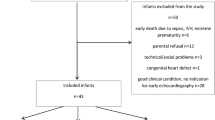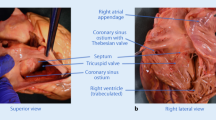Abstract
This study was designed to investigate the impact of postoperative coronary sinus drainage pressure on coronary flow reserve (CFR) assessed by Doppler guidewire in patients long term after Fontan operation. Twenty-nine patients (median age, 17.4 years female, 11) at a median of 10.6 years after Fontan operation were examined with intracoronary Doppler guidewire during cardiac catheterization. Fourteen patients had coronary sinus (CS) drainage to the systemic venous atrium and 15 patients had CS drainage to the pulmonary venous atrium after Fontan operation. Median CS drainage pressure was significantly higher in systemic venous CS drainage compared to pulmonary venous CS drainage (11 vs 5 mmHg, p < 0.0001). Median CFR values for the right and left coronary artery did not differ significantly with respect to CS drainage. There was a positive correlation between coronary flow reserve and pulmonary arteriolar resistance (p < 0.05) in multivariate regression analysis. The site of coronary drainage into the systemic atrium or the pulmonary venous atrium did not significantly affect CFR. Our data do not support a surgical strategy of elective redirection of coronary sinus blood to a low-pressure compartment but support an early staged approach. The positive correlation between CFR and pulmonary resistance demands further evaluation.



Similar content being viewed by others
References
Akagi T, Benson LN, Gilday DL, et al. (1993) Influence of ventricular morphology on diastolic filling performance in double-inlet ventricle after the Fontan procedure. J Am Coll Cardiol 22:1948–1952
Antony I, Nitenberg A, Foult JM, Aptecar E (1993) Coronary vasodilator reserve in untreated and treated hypertensive patients with and without left ventricular hypertrophy. J Am Coll Cardiol 22:514–520
Ardehali A, Ports TA (1990) Myocardial oxygen supply and demand. Chest 98:699–705
Bellamy RF, Lowensohn HS, Ehrlich W, Baer RW (1980) Effect of coronary sinus occlusion on coronary pressure-flow relations. Am J Physiol 239:H57–H64
Cheung YF, Penny DJ, Redington AN (2000) Serial assessment of left ventricular diastolic function after Fontan procedure. Heart 83:420–424
de Leval MR, Kilner P, Gewillig M, Bull C (1988) Total cavopulmonary connection: a logical alternative to atriopulmonary connection for complex Fontan operations. Experimental studies and early clinical experience. J Thorac Cardiovasc Surg 96:682–695
Doucette JW, Corl PD, Payne HM, et al. (1992) Validation of a Doppler guide wire for intravascular measurement of coronary artery flow velocity. Circulation 85:1899–1911
Eicken A, Fratz S, Gutfried C, et al. (2003) Hearts late after Fontan operation have normal mass, normal volume and reduced systolic function: a magnetic resonance imaging study. J Am Coll Cardiol 42:1061–1065
Eicken A, Genz T, Kuhn A, Hauser M, Hess J (2004) Impaired left ventricular function after arterial switch operation: exclusion of significant coronary stenosis with an intravascular Doppler guidewire. Pediatr Cardiol 25:62–64
Fontan F, Baudet E (1971) Surgical repair of tricuspid atresia. Thorax 26:240–248
Fontan F, Kirklin JW, Fernandez G, et al. (1990) Outcome after a “perfect” Fontan operation. Circulation 81:1520–1536
Gould KL, Lipscomb K, Hamilton GW (1974) Physiologic basis for assessing critical coronary stenosis. Instantaneous flow response and regional distribution during coronary hyperemia as measures of coronary flow reserve. Am J Cardiol 33:87–94
Gregg DE (1938) The immediate effects of occlusion of the coronarveins on coronary blood flow in the coronary arteries. Am J Physiol 124:435–443
Hamaoka K, Onouchi Z, Kamiya Y, Sakata K (1998) Evaluation of coronary flow velocity dynamics and flow reserve in patients with Kawasaki disease by means of a Doppler guide wire. J Am Coll Cardiol 31:833–840
Hauser M, Bengel FM, Kuhn A, et al. (2003) Myocardial perfusion and coronary flow Reserve Assessed by positron emission tomography in patients after Fontan-like operations. Pediatr Cardiol 28:28
Hess J (2001) Long-term problems after cavopulmonary anastomosis: diagnosis and management. Thorac Cardiovasc Surg 49:98–100
Hoffman JI (1984) Maximal coronary flow and the concept of coronary vascular reserve. Circulation 70:153–159
Ilbawi MN, Idriss FS, Muster AJ, et al. (1986) Effects of elevated coronary sinus pressure on left ventricular function after the Fontan operation. An experimental and clinical correlation. J Thorac Cardiovasc Surg 92:231–237
Kern MJ, Bach RG, Mechem CJ, et al. (1996) Variations in normal coronary vasodilatory reserve stratified by artery, gender, heart transplantation and coronary artery disease. J Am Coll Cardiol 28:1154–1160
Kirklin JK, Blackstone EH, Kirklin JW, Pacifico AD, Bargeron LM Jr, (1986) The Fontan operation. Ventricular hypertrophy, age, and date of operation as risk factors. J Thorac Cardiovasc Surg 92:1049–1064
Klautz RJ, van Rijk-Zwikker GL, Steendijk P, et al. (1997) Acute elevation of coronary venous pressure does not affect left ventricular contractility in the normal and stressed swine heart: implications for the Fontan operation. J Thorac Cardiovasc Surg 114:560–567
Kouatli AA, Garcia JA, Zellers TM, Weinstein EM? Mahony L (1997) Enalapril does not enhance exercise capacity in patients after Fontan procedure. Circulation 96:1507–1512
Malcic I, Sauer U, Stern H, et al. (1992) The influence of pulmonary artery banding on outcome after the Fontan operation. J Thorac Cardiovasc Surg 104:743–747
McGinn AL, White CW, Wilson RF (1990) Interstudy variability of coronary flow reserve. Influence of heart rate, arterial pressure, and ventricular preload. Circulation 81:1319–1330
Miura T, Hiramatsu T, Forbess JM, Mayer JE Jr. (1995) Effects of elevated coronary sinus pressure on coronary blood flow and left ventricular function. Implications after the Fontan operation. Circulation P2:II298–II303
Mosher P RJJ, McFate PA, Shaw RF (1964) Control of coronary blood flow by an autoregulatory mechanism. Circ Res 14:250–259
Oskarsson G, Pesonen E, Mimkhammar P, Sandstrom S, Jogi P (2002) Normal coronary flow reserve after arterial switch operation for transposition of the great arteries: an intracoronary Doppler guidewire study. Circulation 106:1696–1702
Pantely GA, Bristow JD, Ladley HD, Anselone CG (1988) Effect of coronary sinus occlusion on coronary flow, resistance, and zero flow pressure during maximum vasodilatation in swine. Cardiovasc Res 22:79–86
Rossen JD, Winniford MD (1993) Effect of increases in heart rate and arterial pressure on coronary flow reserve in humans. J Am Coll Cardiol 21:343–348
Scharf SM, Bromberger-Barnea B, Permutt S (1971) Distribution of coronary venous flow. J Appl Physiol 30:657–662
Strauer BE (1990) The significance of coronary reserve in clinical heart disease. J Am Coll Cordial 75:775–783
Ward KE, Fisher DJ, Michael L (1988) Elevated coronary sinus pressure does not alter myocardial blood flow or left ventricular contractile function in mature sheep. Implications after the Fontan operation. J Thorac Cardiovasc Surg 15:511–515
Wilson RF, White CW (1986) Intracoronary papaverine: an ideal coronary vasodilator for studies of the coronary circulation in conscious humans, Circulation 75:444–451
Acknowledgment
This work was supported by grant “Maximilian-Forschungspreis” from Herzkind e.V., Germany
Author information
Authors and Affiliations
Corresponding author
Rights and permissions
About this article
Cite this article
Eicken, A., Sebening, W., Genz, T. et al. Site of Coronary Sinus Drainage Does Not Significantly Affect Coronary Flow Reserve in Patients Long Term After Fontan Operation. Pediatr Cardiol 27, 102–109 (2006). https://doi.org/10.1007/s00246-005-1036-y
Published:
Issue Date:
DOI: https://doi.org/10.1007/s00246-005-1036-y




